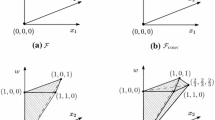Abstract
The bilevel programming problem (BLPP) is a two-person nonzero sum game in which play is sequential and cooperation is not permitted. In this paper, we examine a class of BLPPs where the leader controls a set of continuous and discrete variables and tries to minimize a convex nonlinear objective function. The follower's objective function is a convex quadratic in a continuous decision space. All constraints are assumed to be linear. A branch and bound algorithm is developed that finds global optima. The main purpose of this paper is to identify efficient branching rules, and to determine the computational burden of the numeric procedures. Extensive test results are reported. We close by showing that it is not readily possible to extend the algorithm to the more general case involving integer follower variables.
Similar content being viewed by others
References
E. Aiyoshi and K. Shimizu, Hierarchical decentralized systems and its new solution by a barrier method, IEEE Trans. Systems, Man, and Cybernetics SMC-11(1981)444–449.
G. Anandalingam and D. White, A penalty function approach for solving bilevel linear programs, Working Paper, Department of Systems, University of Pennsylvania (1988).
J.F. Bard, Coordination of a multidivisional firm through two levels of management, Omega 11(1983)457–468.
J.F. Bard, Convex two-level optimization, Math. Progr. 40(1988)15–27.
J.F. Bard and J.T. Moore, A branch and bound algorithm for the linear bilevel programming problem, SIAM J. Sci. Statist. Comput. 11(1990)281–292.
J.F. Bard and J.E. Falk, An explicit solution to the multi-level programming problem, Comput. Oper. Res. 9(1982)77–100.
T. Basar and H. Selbuz, Closed loop Stackelberg strategies with applications in optimal control of multilevel systems, IEEE Trans. Auto. Control AC-24(1979)166–178.
W.F. Bialas and M.H. Karwan, On two-level optimization, IEEE Trans. Auto. Control AC-27(1982)211–214.
W. Candler and R. Townsley, A linear two-level programming problem, Comput. Oper. Res. 9(1982)59–76.
R. Cassidy, M.J. Kirby and W.M. Raike, Efficient distribution of resources through three levels of government, Manag. Sci. 17(1971)462–473.
T.A. Edmunds, Algorithms for nonlinear bilevel mathematical programs, Ph.D. Dissertation, Department of Mechanical Engineering, University of Texas at Austin (1988).
Y. Fan, S. Sarkar and L. Lasdon, Experiments with successive quadratic programming algorithms, Working Paper, Department of General Business, University of Texas, Austin (1985).
J. Fortuny-Amat and B. McCarl, A representation and economic interpretation of a two-level programming problem, J. Oper. Res. Soc. 32(1981)783–792.
P. Hansen, B. Jaumard and G. Savard, A variable elimination algorithm for bilevel linear programming, RUTCOR Research Report RRR 17–89, Rutgers University (1989).
J. Júdice and A. Faustino, The solution of the linear bilevel programming problem by using the linear complementarity problem, Investigacao Operacional 8(1988)77–95.
P.B. Luh, T.S. Chang and T.K. Ning, Three-level hierarchical decision problems,Proc. 5th MIT/ONR Workshop on Command, Control, and Communications Systems, Monterey, CA (1982).
J.T. Moore and J.F. Bard, The mixed integer bilevel programming problem, Oper. Res. 38(1990)911–921.
M. Simaan and J.B. Cruz, Jr., On the Stackelberg strategy in nonzero-sum games, J. Optim. Theory Appl. 11(1973)533–555.
J. Singhal, R.E. Marsten and T.L. Morin, Fixed order branch-and-bound methods for mixed-integer programming: The ZOOM system, ORSA J. Comput. 1(1989)44–51.
B. Tolwinski, Closed-loop Stackelberg solution to a multi-stage linear-quadratic game, J. Optim. Theory Appl. 34(1981)485–501.
Author information
Authors and Affiliations
Additional information
This work was supported by a grant from the Advanced Research Program of the Texas Higher Education Coordinating Board.
Rights and permissions
About this article
Cite this article
Edmunds, T.A., Bard, J.F. An algorithm for the mixed-integer nonlinear bilevel programming problem. Ann Oper Res 34, 149–162 (1992). https://doi.org/10.1007/BF02098177
Issue Date:
DOI: https://doi.org/10.1007/BF02098177




